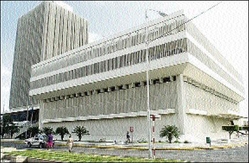
The Bank of Jamaica in downtown Kingston. - FILE
In the previous instalment of this series of articles, we pointed to the seeming attempt, early in the decade by the central bank, at obfuscation over its use of CDs in the market and the impact of these instruments on the BOJ's balance sheet. However, since 2004, the auditors have labelled the Bank's CDs as open market liabilities.
The following statement appeared in Note 15 of its 2007 report:
"Open market liabilities is part of the process of controlling liquidity in the financial system the Bank acquires funds from or makes funds available to financial institutions and this is effected by entering into short-term agreements with the institutions. Receipt of funds is evidenced by the Bank issuing, to the depositor, certificates of deposit."
The acceptance of the above statement by the auditors, the Government, the financial community, academia, and the public at large, if not responsible for, significantly contributes to current operating difficulties facing the BOJ.
Based on the known and established principles of central banking practice, can the BOJ legally accept funds from any depositor? And, if controlling liquidity is an open market activity, and the both the bank and the auditors use the term "open market" to describe the BOJ's liquidity management activities, can this characterisation of the BOJ be accurate if the bank operates without the use of underlying securities?
The balance sheet of May 22, 2002, was the last publication from the BOJ with the line item: Securities Sold Under Agreement to Repurchase. The next published balance sheet of June 12 combined the acknowledged CDs with reverse repurchase agreements and called them open market instruments. This camouflage was the prelude to an announcement to be made three years later, May 27, 2005. On that date, the BOJ announced that it would no longer use reverse repurchase agreements to conduct open market operations -.meaning, henceforth, only CDs would be used to drain liquidity from the system.
On May 25, 2005, the date of the last published balance sheet before the announced cessation of reverse repurchases, Open Market Instruments (OMI) stood at $160.7 billion. Concurrently, securities, LRS and investment debentures totalled $85.1 billion - making a difference of $75.6 billion, (approximately US$ 850.million).

Derick Latibeaudiere, Bank of Jamaica governor. - File
That decision by the central bank carries ponderous implications for the financial system and the country at large. First, if there are no restrictions on the bank, does this mean that the bank, having converted all its liquidity obligations to CDs, with the declared statement that CDs are guaranteed by the bank, can start a new round of reverse repurchase agreements by adding another $85.0 billion to the balance sheet? What if the bank made an argument that imports are increasing and the NIR must be increased? Or, conversely, if the ministry should put a limit equating marketable securities to the bank's liquidity obligations and the bank had to unwind. Where would the liquidity go? And whither the NIR?
Prior to 1995, the bank fully displayed certificates of deposit on its balance Sheet. It is understandable that the bank might not want to disclose its CD stock because it might be embarrassed to give the impression that it is a deposit-taking institution and simply investing the proceeds of deposits and not skilled in the art and practice of open market operations management. It should recognise that the pretence to be working within an open-market system was shattered in 2007 when the bank issued three two-year, two 18-month, and three one-year CDs.
Liquidity: Causes and Consequences
In 2007, after the BOJ had relinquished the delicate instruments of central banking artistry (repos) for the crude and archaic CDs, the commentary after each issue of a new CD was: "As part of its liquidity management strategy, the Bank of Jamaica offered a special instrument."
It is ironic that the BOJ would require a management strategy to deal with 'liquidity'. This liquidity, excess Money Supply (M2A), Domestic Hot Money (DOHOMO), did not arise ex nihilo, it was created by the bank itself. As noted earlier, liquidity had increased by $112 billion during the period 1996-2007. Over this same period, the audited financial statements of the bank showed that a total of $180B was spent on interest expenses. Ipso facto, the liquidity balance of $129 billion on December 31, 2007, would include the net interest adjustments on domestic activities because the sterilised foreign interests earned are not available for netting off locally. So, could the central bank be the primary provider of excess liquidity with its $180 billion interest credits since 1996? If the BOJ interest credits do fuel liquidity, is this perpetual motion? As a challenge, the BOJ should be asked to explain the precise monetary impulse (effect on liquidity) of its $180 billion certified as payments from the Bank into the system.
Liquidity management essentially implies 'sterilisation' of funds. The 'safest' way to sterilise is to apply the bank's liquidity obligations into an asset account which will not re-enter the monetary system on a permanent basis. Listed in the central bank's balance sheet and the monetary base profile is the asset classification - deposits with the US central bank. By using this facility the BOJ could safely sterilise its liquidity obligations.
The incumbent governor, in his inaugural quarterly media address in 1996, made the following comment regarding sterilisation:
"While the central government deposits in the bank have increased by some $1.8 billion from end March to the end of June, the concurrent US$102 million, expansion in NIR required an expansion of over J$1.8 billion in the bank's stock of reverse repurchases outstanding, to sterilise the proceeds."
The above comment confirmed the bank's sterilisation process which in turn supports the expansion of an unearned, artificial and liquidity induced NIR.
See part IV in this Friday's Financial Gleaner.